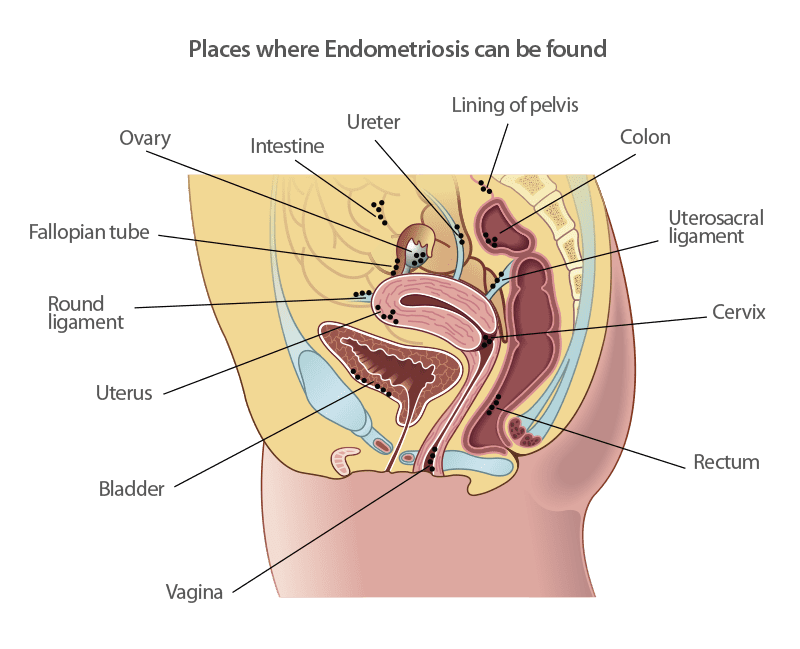
I have very painful or slightly painful periods.
I have severe menstrual cramps.
I have abdominal swelling.
I have pain during sex.
If you have all of these ENDOMETRIOSIS SYMPTOMS, you may have a disease called ENDOMETRIOSIS and not even know it.
This disease is very difficult to diagnose because it can be confused with other conditions, which is why only specialist doctors can detect it.
WHAT IS ENDOMETRIOSIS?
ENDOMETRIOSIS is defined as the presence of endometrial-like tissue outside the uterus. Endometriosis triggers a chronic inflammatory reaction resulting in pain and adhesions. Adhesions develop when scar tissue attaches separate structures or organs together. The activity and the complaints due to endometriosis may vary during the woman’s menstrual cycle as hormone levels fluctuate. Consequently, symptoms may be worse at certain times in the cycle, particularly just prior to and during the woman’s menstrual period.
While some women with endometriosis experience severe pelvic pain, others have no symptoms at all or regard their symptoms as simply being ‘ordinary menstrual pain’. In rare instances, cyclical pain can also involve the upper part of the abdomen e.g., under the ribs or the chest.
It is estimated that between 2 and 10% of the women within the general population have endometriosis and that 30% - 50% of the infertile women have endometriosis.
Women with endometriosis often experience severe symptoms and significantly reduced quality of life, including restraint of normal activities, pain/discomfort, and anxiety/ depression.

What are the SYMPTOMS OF ENDOMETRIOSIS?
The symptoms of endometriosis are not very specific, the DIAGNOSIS OF ENDOMETRIOSIS cannot be made by the symptoms alone. However, symptoms can give a doctor a first hint towards the diagnosis of endometriosis.
The SYMPTOMS OF ENDOMETRIOSIS are:
- Painful menstrual periods (dysmenorrhea).
- Non-menstrual pelvic pain or pain occurring when a woman is not menstruating.
- Pain during or after sexual intercourse (dyspareunia).
- Pain emptying bladder/painful urination (dysuria).
- Pain emptying bowel (dyschezia).
- Painful rectal bleeding or the presence of blood in the urine (haematuria).
- Shoulder tip pain.
- Cyclical lung problems (pneumothorax).
- Cyclical cough, chest pain, or coughing of blood (haemoptysis).
- Cyclical scar swelling and pain.
- Fatigue.
- Infertility.
- Any other cyclical symptom. Cyclical SYMPTOMS are SYMPTOMS that develop a few days before a woman’s menstruation and disappear a few days after her menstruation has stopped, or symptoms that occur only during the menstruation. The symptoms reappear the next month, following the woman’s menstrual cycle. Severe pain can be measured by not doing your normal daily activities (without taking pain medication).
Types of Endometriosis?
There are actually several different manifestations of the disease. We can divide Endometriosis into 3 clinical presentations, which may appear alone or simultaneously and it is very important that it is attended by medical specialists:
Superficial Endometriosis – these are Endometriosis implants that do not infiltrate more than 5 mm below the surface of the peritoneum (the layer that lines the abdomen and covers the various organs).
Ovarian ENDOMETRIOMA – these are lesions that infiltrate the ovary and form cysts with bloody content. As they are chronic lesions, the blood contained within the cyst is old blood, which has a “chocolate” appearance when the ENDOMETRIOMA is emptied during the laparoscopic surgical procedure.
Deep ENDOMETRIOSIS – these are lesions that infiltrate more than 5 mm below the surface of the peritoneum. These lesions can infiltrate nearby organs, mainly the bladder, vagina, ureter and intestine. It is the most aggressive presentation of the disease and the surgical treatment is complex and best carried out by experienced multidisciplinar teams.

What causes endometriosis?
The exact cause of endometriosis is still unknown, but several theories are suggested:
Retrograde menstruation - menstrual bleeding and tissue are directed in the reverse direction, ie they go from the uterus to the pelvis through the fallopian tubes
Endometrial tissue from the uterus can be transported through the blood and lymph vessels to any extra-uterine site, including the pelvis.
Changes in the immune system allow endometrial tissue outside the uterus to grow and develop.
Coelomic metaplasia is the concept that cells of the peritoneum and ovarian surface can transform into endometrial tissue with certain stimuli, such as irritation from retrograde menstruation or infection.
Genetic and epigenetic.
If you have symptoms of suspected endometriosis, you must undergo a study protocol to properly diagnose you, and offer you a tailored therapeutic plan.
It is important to remember that not every woman who suffer from one (or more) of the above symptoms is necessarily a carrier of Endometriosis. These are symptoms that MAY or may not be related to the disease. However, all women who have any of the above-mentioned symptoms in a very intense level should undergo a gynecological evaluation and an investigation for Endometriosis.
Not every woman with Endometriosis will experience difficulty in getting pregnant, but it is known that in general there is a decrease in fertility in the group of women with Endometriosis. However, there are many other causes of infertility that should also be investigated and not all women who are trying to conceive and are not succeeding are carriers of Endometriosis.
Treatment
Don't worry! There are ways to live WITHOUT PAIN.
There is no cure for endometriosis, but there are surgical and non-surgical treatment options for pain and infertility caused by this condition. We invite you to the section of our website where we talk about it.
